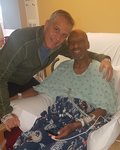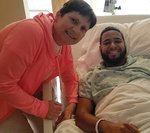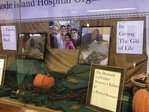While the phrase “organ donor” is often associated with life-saving or life-changing gifts from people who’ve passed away, thousands of organs each year are donated by people who …
This item is available in full to subscribers.
We have recently launched a new and improved website. To continue reading, you will need to either log into your subscriber account, or purchase a new subscription.
If you are a current print subscriber, you can set up a free website account by clicking here.
Otherwise, click here to view your options for subscribing.
Please log in to continue |
|





While the phrase “organ donor” is often associated with life-saving or life-changing gifts from people who’ve passed away, thousands of organs each year are donated by people who are still alive.
Living organ donors, as the name suggests, are people who donate an organ while alive. They can donate organs such as a kidney or a lung or a portion of the liver, pancreas or intestine.
Paul and Diane Gebhart of Cranston have each donated one of their kidneys. The need is significant – as of April 28 of this year, 90,762 people were on the waiting list for a kidney transplant, according to the U.S. Department of Health and Human Services.
Diane donated her kidney in 2018. The decision to become a living donor, she said, was rooted in her faith. “It was like an answer to a prayer for me,” Diane said. “I was just praying in church for God to not let me be afraid to help a stranger.”
Diane recalls that “within a few days of that prayer,” while on Facebook, she found a woman in need of a kidney transplant. “I immediately knew that I was going to donate to her and I started the process,” she said.
Then, after several months of testing and preparation, a different donor’s kidney went to the planned recipient of Diane’s gift due to a change in circumstances. But she was still determined to donate a kidney to someone in need.
That’s when she learned that Nicholas Peguero, the 24-year-old son of one of one of her co-workers at the YMCA of Greater Providence, was in need of a kidney donation. Within weeks, she was tested to make sure that she was compatible with Peguero.“I kept it private until I was sure that I was a match,” Diane said. “He then called his mom, who sat right next to me at work. It was kind of weird because I knew what was going on in that conversation. It was exciting and happy and joyful, and it was unique that I ended up knowing the person that I was going to donate to.”
While Diane knew her recipient before the procedure, Paul was a non-directed donor. This means that he did not know who his kidney would go to until after the transplant was already done. As the day of the procedure drew closer, Paul became “madder and madder” to know who he would be donating a kidney to.
Paul and the recipient of his gift, John McCarty of Pawtucket, have formed a strong relationship since the transplant took place. Before the pandemic, the two would meet for coffee once a month. Paul said he considers himself lucky to have gained a friend through his donation. Beyond that, he is happy to have helped make such a profound difference in someone else’s life.
“It’s life-changing, it’s a game changer, there’s no question about it,” he said. “I’d do it a second time. I wish I had three kidneys.”
Paul said that aside from two or three weeks of pain from the procedure itself, he has experienced no side effects from only having one kidney.
According to Dr. Adena Osband, a transplant surgeon at Rhode Island Hospital, the procedure is minimally invasive. Only three incisions are
made, two of which are about half an inch in diameter and one that is about two inches in diameter.
She said kidney transplants, just as all other surgeries, present some rare risks, such as bleeding, infection and anesthesia. “These risks are small,” she said, “but they’re not completely nonexistent.”
Donors can expect little to no issue with kidney function after they recover from the surgery, according to Osband.
“Patients are starting out with 100 percent kidney function,” she said. “We take out one kidney. So they dropped to 50 percent. The remaining kidney will compensate, and get them back to about 70 to 75 percent [function]. So, we do extensive testing before we proceed to make sure that the patients start out at excellent, so when they drop to very good, we expect them to be fine. Patients will have aslight decrease in their kidney function and a slight increase in their blood pressure.”
According to HHS, in 2020, only 30.5 percent of kidney donations were from living donors, a significant decrease from 2019 at 38.5 percent. This has been a continuation of the downward trend since 2003 when 52.9 percent of donors were living.
Paul believes that the reason few people donate their kidneys is because of a lack of education on the topic. He was only convinced to donate a kidney himself after attending an event to honor donors with Diane. He was inspired by the emotional stories of those waiting for a kidney transplant.
Through educating others about the recovery process, the lack of long-term effects and the importance of these donations, Paul hopes that others will donate their kidneys to those who need them.
Osband also said that she believes a lack of education on the subject is what holds some back from donating. “I think that there is a lot of fear of the unknown and there’s a lot of misinformation,” she said. “A lot of people believe that if you check off that you want to be an organ donor and you are in the trauma bay after a horrible accident, you will get different care. Of course, that’s 100 percent incorrect. A lot of the non-directed donors that we have tell us that they heard a story of somebody who needed an organ and realized, ‘I can do this.’”
If you are interested in becoming a living kidney donor or want more information about living kidney donations, visit www.lifespan.org/centers-services/transplant-center
Comments
No comments on this item Please log in to comment by clicking here